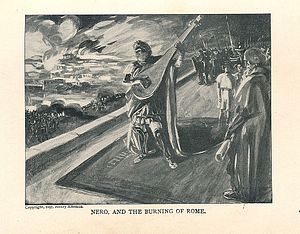Quo Vadis is a novel that was originally written in Polish. Its story is set in 1st century AD Rome, with Emperor Nero’s exploits, the persecution of Christians, and the Great Fire of Rome serving as its canvas. Arguably, the main protagonist – more than any particular person – is Christianity itself. At first, it seemed that such a story would appeal mostly to the European and more generally Christian readers across the globe and thus its reach in Asia would have been limited. Yet, the number of its editions tells quite a different story.
Written by the Nobel laureate Henryk Sienkiewicz, the book was originally published in newspaper installments throughout 1895 and 1896. It was subsequently published as a full novel in 1896 and thus 2016 marks the 120th anniversary of the book’s printing and, incidentally, the 100th anniversary of Sienkiewicz’s death. Public readings of the novel were held in more than 2,000 places across Poland to mark the anniversary. A similar event took place even in distant New Zealand, where it was organized by the Polish diaspora, while the Polish Institute in New Delhi held an “India is Reading Sienkiewicz” event on October 27, 2016.
The anniversary celebrations served as an occasion for the National Library of Poland to attempt at comprehensive counting of all the editions of the novel. In all, 2,002 editions have been traced, counting digital and abbreviated forms. Of these, 192 were Polish editions and many others were naturally those in more popular European languages, for instance 294 in German. The novel was so popular in Europe in its first years of circulation that the Russian and English translations came out in the same year as the Polish original – 1896. The novel’s popularity gave birth also to its other incarnations such as the 1909 French opera and the 1951 Hollywood movie. As for the Asian and Middle Eastern editions of the book, 41 editions have been traced in Chinese and in Japanese, 39 in Korean, 17 in Turkish (counting Ottoman Turkish), 15 in Persian, 11 in Hebrew , seven in Arabic, six in Armenian, five in Vietnamese, three in Hindi and in bahasia indonesia, two in Bengali, Malayalam, and Georgian, and one in Burmese, Gujarati and Tamil.
The first Asian translation of the full version novel was published in Tokyo by a Protestant missionary, Unshu Matsumoto, in 1907. At that time the greatest Chinese contemporary writer Lu Xun and his brother Zhou Zuoren were studying in Japan and got to read the novel there among Sienkiewicz’s other works, which they started translating into Chinese soon after. The first Chinese edition of Quo Vadis came out in 1922. It was translated by Xu Xusheng and Qiao Zengqu, who were probably inspired by Lu Xun’s high praise of Sienkiewicz’s works and the seven editions of the novel that existed in Japan by that time. The first Chinese versions were translated from Japanese and Russian or English (as happened with many other translations). And it was not until 1983 that the novel got its full direct translation from Polish into Chinese by Lin Hongliang, a long-time promoter of Polish literature in China.
The story of the Vietnamese translation, however, starts with Nguyen Huu Dung, an excruciatingly gifted translator and Polish literature pundit – who was interestingly of a more technical background. Published in 1985, his version was translated directly from Polish. Despite the fact that Polish literature has been translated into Vietnamese since the middle of the 20th century, Nguyen Huu Dung remains the only Vietnamese translator of Sienkiewicz’s works. It seems to be an exception as in most of Asian languages the new editions of Quo Vadis have been regularly retranslated.
The eminent Japanese writers of the 20th century, Yukio Mishima and Yaeko Nogami, were greatly inspired by Quo Vadis. Korean readers have been inspired by the Christian motives of the story, and Chinese romance lovers captivated by the story of main protagonists, Vinicius and Ligia. Even the high number of abbreviated and rewritten editions for children and adolescents additionally proves the popularity of the story in Asia. The novel is also clearly witnessing a revival of sorts with its 16 Chinese editions published only from 2000 till 2016.
Marta Tomczak is a linguist, economist and PhD candidate at the Institute of Political Studies, Polish Academy of Sciences, with a decade of experience in China and Turkey as business analyst and manager.

































